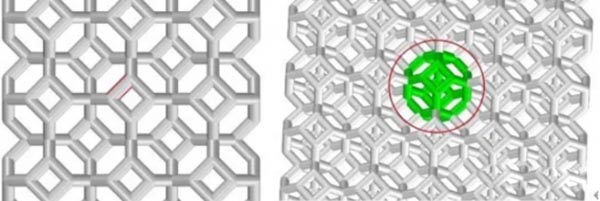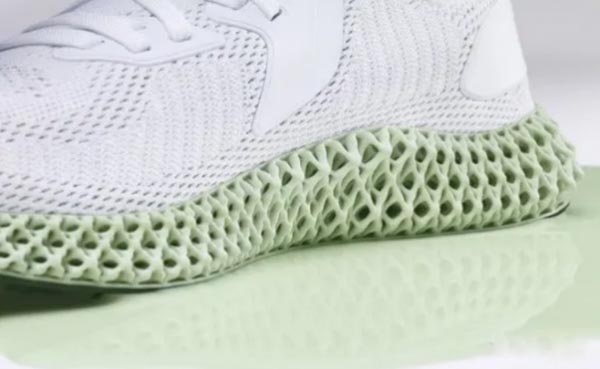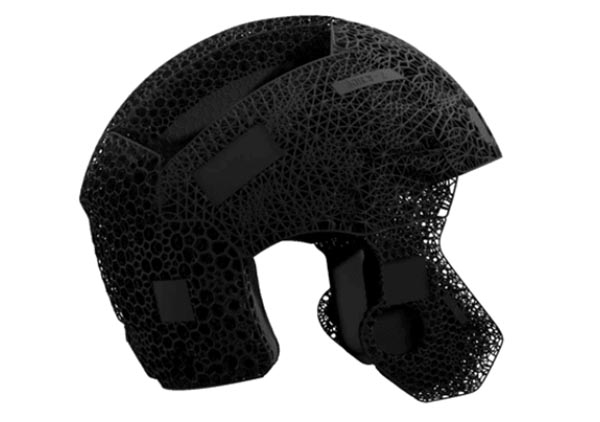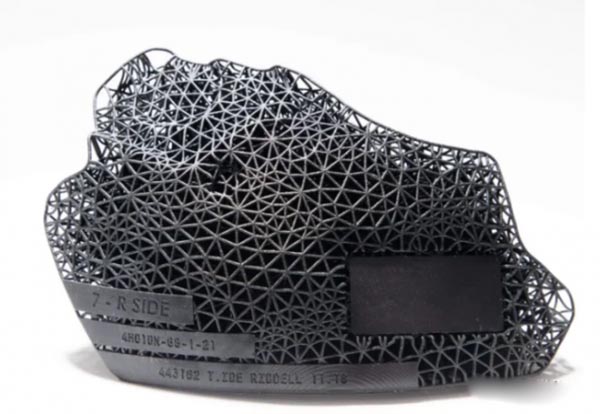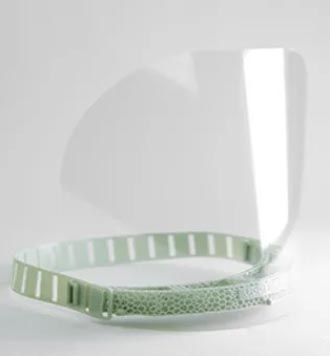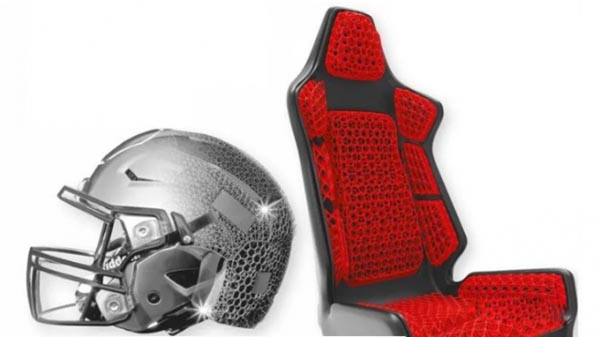3D printing is a lean way to create new opportunities for cushioning and protecting products

As sports shoes with 3D printed insoles have opened up in the consumer market, the key technology of which – 3D printed lattice structure based on elastic plastic material (3D printed lattice structure) has attracted the attention of the manufacturing industry as a new generation of buffer and protection material to replace the traditional foam plastics.
In daily life, sports shoes, orthopedic insoles, protective helmets, car seats, earphones and many other products are no lack of foam applications.So, can 3D-printed lattice structures also be used in a wider range of fields?How can manufacturers of sports and protective parts/components use 3D printing technology to upgrade their product performance?
Oechsler, an internationally renowned plastic parts manufacturer, has accumulated a large number of production cases in the field of lattice lattice structure 3D printing, and established value-added services in the whole value chain of additive manufacturing from product design and development to mass production in the field of plastic 3D printed parts production.In this issue, 3D Science Valley and GuYou will learn about the lean way behind mass production through the 3D printing lattice structure production case of Yuke Xerox located in Taicang, China.
‘Disturbing’ the 3D printed lattice structure of plastic foam
Consumer foamed plastics are widely used……
Hard foam can be used as thermal insulation and sound insulation materials, heat preservation materials for pipes and containers, floating materials and shock absorbing packaging materials.Traditional soft foam materials, such as EVA, have the functions of buffering, sound absorption, shock absorption, heat preservation and filtration due to their light weight and good softness. They are widely used in electronics, home appliances, automobiles, sports and leisure industries [1], as lining materials and foam artificial leather.[1]
In industrial applications, glass fiber reinforced polyurethane foam made by reactive injection molding has been used as structural parts of airplanes, automobiles, computers, etc.The foam made of polybenzimidazole filled with hollow glass beads, which is light and high temperature resistant, has been used in spacecraft.[2]
In some areas, 3D-printed lattice structures have begun to replace traditional foam.
Taking sports goods in the consumer field as an example, football protective pads and athletic shoes insole are the application scenarios of traditional EVA foam materials, which have buffering and energy feedback effects.One of the most commonly used foam in sneakers is a closed-cell foam called EVA (vinyl acetate).[3]
EVA foam has long been used as a manufacturing material for shoe insoles.At what point, then, could manufacturers turn their sights to 3D-printed lattice structures?
Still take sports shoes insole manufacturing as an example.Unveiling the “veil” of 3D printing lattice structure, the important reason that attracts the attention of athletic shoe manufacturers is that the application of 3D printing can enable them to get rid of the limitations of the traditional insole manufacturing method and provide complex and high-performance overall design.
Unlike traditional processes, which require manufacturers to assemble multiple parts to create different performance zones in a single midsole, 3D printing allows soles with different functional zones to be digitally created from the same plastic part.In the midsole of 3D printed shoes, the key role is the 3D printed lattice structure.
Wider applications are possible!
The 3D-printed lattice structure can be considered as a porous structure formed by the periodic combination of a large number of identical lattice elements in some form.The performance of this structure has high design flexibility. By adjusting the relative density of lattice, configuration of single cell and size of connecting rod, the perfect balance of strength, stiffness, toughness, durability, static and dynamic mechanical properties of the structure can be achieved.[4]
This means that by adjusting the size, diameter and shape of individual cells, it is possible for designers to achieve higher design aesthetics and mechanical properties.Combined with 3D printing’s ability to create complex structures, designers are able to focus more on the product itself, which opens up a wider range of applications for 3D printed lattice structures.
Next, we will take a look at how 3D printing lattice structure is combined with products and what possibilities it brings to product design innovation and performance improvement through the case that Yuke Xerox has carried out mass production.
From sneaker midsole to 3D printing lean manufacturing full value chain
Yuke Xerox is a supplier of lean manufacturing solutions for high value-added products in high volume production, with a unique market position in the competition. Yuke Xerox also has the latest technology measurement technology, extremely high standards of quality and environmental management.In China, euxerox manufactures high quality products for the automotive, medical, industrial and footwear sectors in Taicang.
L Midsole of sneakers
Yuke Xerox has entered the 3D printing market from the manufacturing of the middle soles of sports shoes. Yuke Xerox pays attention to the innovation and research and development of advanced technology, and is in the forefront of the industry in the field of lattice structure design for additive manufacturing and additive manufacturing (3D printing) of this kind of structure.Yuxerox has produced more than 2 million 3D printed parts through production bases in Germany, the United States and China (Taicang). Based on this, Yuxerox has established the full value chain value-added services of additive manufacturing from 3D printed product design and development to mass production of finished products.
The above image shows a 3D printed shoe insole manufactured using Carbon’s DLS™ high-speed light-curing 3D printing equipment. The Taicang production site of Yuke Xerox delivers nearly 1 million pairs of shoe insoles annually.
Yuke Xerox has targeted the refinement of customer needs, the use of lattice design has a unique design flexibility, to achieve customer product required functions, performance and other requirements.Lattice design often has complex geometric structure, and manufacturing complex structure is just one of the competitive advantages of additive manufacturing technology in industrial manufacturing. It can be said that the excellent combination of lattice design and additive manufacturing will bring unique innovation to customers’ products.
When it comes to mass production of 3D printed products, consistency of quality is crucial.Yuke Xerox through strict production environment control, the selection of appropriate printing technology and optimized post-processing process to achieve the consistency of printing volume production quality.
The whole production workshop of Yuke Xerox, including raw material storage warehouse, realizes stable temperature and humidity control through independent control system, and forms closed-loop control with the implementation of monitoring points in different regions, to ensure the stability of the entire printing production process environment.
Yuke Xerox has the largest number of Carbon 3D printers in the world.While additive manufacturing uses a layer-by-layer deposition principle, where the mechanical properties are dependent on the printing direction of the parts (anisotropy), Carbon’s DLS digital light synthesis technology produces parts that behave the same (isotropic) in all directions.This is one of the conditions to ensure the consistency of the quality of printed products.
For some 3D printed products requiring secondary curing, the quality of post-treatment of the product will not only directly affect the appearance performance, but also directly determine the mechanical functional characteristics of the final product.Yuke Xerox’s ability and rich experience in post-treatment process research and development provide effective guarantee for the quality consistency of mass production products.
1. Protective helmet
Strong impact of football helmet pads, designers through the athletes performance requirements for protective helmets, choosing the appropriate lattice shapes, by fine adjusting the thickness of each support bar diameter to adjust the stiffness of the lattice structure of ten independent lattice support structure for special adjustment, finally realizes the lattice structure of the internal damping pillar and the impact of the athletes experience in sports direction relative to the absorption and dispersion energy.
In addition to providing excellent protection, the helmet pad provides excellent air permeability and excellent fit.
1. Mask protection area
During the fight against COVID-19, health care workers experienced discomfort after wearing protective masks for long periods of time.
The protective mask produced by Yuke Xerox adopts the advanced lattice design for additive manufacturing and optimizes the crystal cell shape. The material is high performance elastomer. After printing and forming, the wearing comfort and reliability of the protective mask are significantly improved.
1. Car seats
High-end car manufacturers are interested in the new experience of comfort provided by 3D-printed lattice structures, with advanced designs for additive manufacturing integrated into car seats.
The 3D printed lattice structure produced by Yuke Xerox can be used as the intermediate layer material of the seat, which is also the comfort layer of the seat.In different areas of the seat, the design of 3D printed lattice cell is different. The diversity of lattice design makes different areas of the seat have different functions and performance.
The application of the seat comfort layer well reflects the high design flexibility of the performance of 3D printed lattice structure.
Lean way to reinvent products!
The 3D-printed lattice structure brings the possibility of a breakthrough in designs that were previously unable to be realized due to the limitations of the foamed plastics process.The value-added service system of the full value chain of additive manufacturing established by Yuke Xerox provides the mass lean manufacturing delivery capability for the advanced design of additive manufacturing to be transformed into real products.
Bicycle seat, shoe insole, car seat, helmet padding, orthopedic insole, headset….With the abundance of high-performance 3D printing materials, product development teams will have more new opportunities to reshape product comfort and safety through new design thinking, new materials and additive manufacturing.

